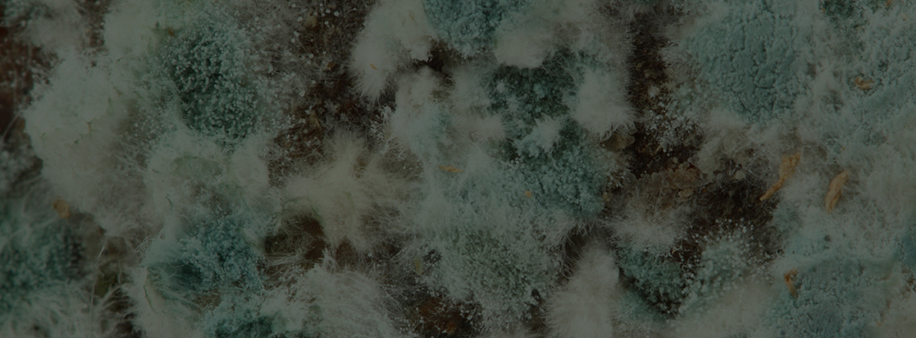
Mold is a type of fungus. It is present almost everywhere, including the air. There are up to 100 common indoor mould types that have the potential for creating health problems such as Aspergillus and Penicillium species.
The most toxic moulds are those that are capable of producing chemicals called mycotoxins. Mycotoxins are small molecular weight toxic molecules produced by some species of mould such as Stachybotrys (black mould), they are particularly important because they are known to be highly toxic.
If you have toxic mould in your workplace, you are breathing Mycotoxins in every day as these chemicals will be present within the mould spores released into the air.

What are the symptoms of mould exposure?
Mould can affect people in different ways, and it often causes no symptoms at all.
On the other hand for those people who are sensitive to mould or have weakened immune or respiratory systems a range of symptoms such as coughing, wheezing, nose stuffiness, red or itchy eyes, skin rash and sore throats can occur. Particular mould's may also cause an asthma attack in people with asthma, and increase breathing difficulty in those with a chronic respiratory disease.
Toxic mould exposure is also linked to health issues like memory loss, headaches, infant pulmonary haemorrhage and even cancer.
Tips on how to prevent mould growth?
Here are five tips on how to prevent moisture and ultimately mould proliferation:
Inspect buildings for evidence of water damage or dampness and visible mould as part of routine building maintenance program. Look out for condensation and wet spots; surface moisture detectors are a good way of identifying damp issues that might not be visually obvious such as leaks in inaccessible voids where mould can grow undetected.
Repair any plumbing leaks and any leaks in the building structure as soon as possible.
Prevent moisture from condensation by increasing surface temperature or reducing the moisture level in the air (humidity). To increase surface temperature, insulate or increase air circulation. To reduce the moisture level in the air increase ventilation (if the outside air is cold and dry), or dehumidify (if outdoor air is warm and humid).
Perform regular scheduled HVAC inspections and maintenance, including filter changes, drip pan cleans and flow checks.
Vent moisture-generating appliances and environments, such as dryers, cooking areas and bathrooms.
How to remove mould?
A mould growth issue indicates that there is a problem with water or moisture. This is the first problem to address.
When removing the mould infestation itself follow these 3 key actions:
Remove any mouldy items. Once mould starts to grow in carpet, insulation, ceiling tiles, drywall, or wallboard, the only way to deal with the problem is by removal and replacement.
Remove or replace carpets and upholstery that have been soaked and cannot be dried promptly.
Properly clean and dry the area as you can still have an allergic reaction to parts of the dead mould that may contain residual mycotoxins. This will also prevent reoccur from viable mould spores that may remain on surfaces.
Note: Mould growth can be removed from hard surfaces with commercial products, soap and water, or a bleach solution of no more than 1 cup of bleach in 1 gallon of water to kill mould on surfaces.
If you have an extensive amount of mould and you do not think you can manage the cleanup, you may want to contact a professional who has experience in remediating mould infestations.
How to test for the presence of mould?
A simple way to identify the presence of mould is to take a surface swab of any visibly effected areas. The swab sample can then either by tested for the general presence of mould or a more detailed analysis can be carried out to identify if any toxic mould species are present.
There are a number of limitations to simply taking surface swabs as follows:
They do not confirm if airborne spores are being released. It is important to understand if the mould infestation is actively releasing spores into the atmosphere which ultimately may cause health issues and further spread into other areas.
Only visually identifiable and easily accessible surfaces can be tested using surface swabs. It is common for mould infestations to occur in voids that are visually un-detectable.
Results from surface swabs can not be used to provide advice relating to the level of exposure and therefore can not give an indication to whether an area is safe to occupy.
Ideally mould exposure testing should measure the airborne levels of mould spores using either spore traps or an impact sampler. This form of testing involves sampling a measured volume of the air which is then collected onto a filter or agar plate that can be then analysed in a laboratory.

There are a number of advantages to this form of testing:
The result is quantitive in relation to actual exposure and therefore can be used to make recommendations as regards to safety.
It is possible to identify if Mycotoxins are present within the air and exposure to these harmful chemicals is occurring.
This form of testing will pickup any active hidden mould that is present within the inner structure of the building that might cause an issue to occupants
A key factor when considering to test for the presence of mould is the interpretation of the results and therefore the sampling strategy used must be appropriate for the aim of the exercise.
Contact Us
Please fill in the short form below for any enquiries.
Search
Please fill in the short form below for any enquiries.